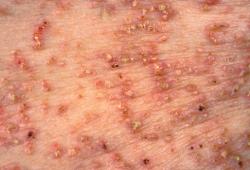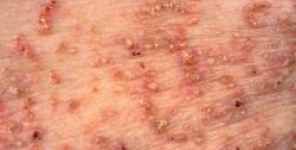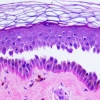Nuove mutazioni di ATP2A2 in un ampio campione di individui con malattia di Darier
 La malattia di Darier (DD) è una rara malattia autosomica dominante della pelle causata da mutazioni in ATP2A2, che è espresso sia nella pelle che nel cervello e che codifica per SERCA2.
La malattia di Darier (DD) è una rara malattia autosomica dominante della pelle causata da mutazioni in ATP2A2, che è espresso sia nella pelle che nel cervello e che codifica per SERCA2.
Abbiamo individuato le regioni codificanti di ATP2A2 in un totale di 95 individui senza storia di DD per identificare le mutazioni patogene. Abbiamo identificato 66 mutazioni potenzialmente patogene in ATP2A2 per 74 soggetti su 95 con DD di cui si pensa che 45 (68%) siano nuove.
Quarantanove (74%) sono uniche per una sola persona mentre 17 (26%) sono state trovate in più di una persona o in sovrapposizione con le varianti individuate precedentemente. I risultati suggeriscono che le mutazioni in ATP2A2 potrebbero non essere specifiche di ciascuna famiglia, come invece si pensava prima. Lo spettro delle mutazioni identificate porterà ad una maggiore comprensione della patogenesi di DD.
Storia della pubblicazione:
Titolo: Novel ATP2A2 mutations in a large sample of individuals with Darier disease
Rivista: The Journal of Dermatology. doi: 10.1111/1346-8138.12082
Autori: Elaine K. Green, Katherine Gordon-Smith, Susan M. Burge, Detelina Grozeva, Colin S. Munro, Sherine Tavadia, Lisa Jones, Nicholoas Craddock
Affiliazioni: MRC Center for Neuropsychiatric Genetics and Genomics, Department of Psychological Medicine and Neurology, School of Medicine, Cardiff University, Cardiff, UK
Department of Psychiatry, Neuropharmacology and Neurobiology Section, National Centre for Mental Health, University of Birmingham, Birmingham, UK
Department of Dermatology, The Churchill Hospital, Oxford, UK
Department of Dermatology, Southern General Hospital, Glasgow, UK
Department of Dermatology, Crosshouse Hospital, Ayrshire, UK
Abstract:
Darier disease (DD) is a rare autosomal dominantly inherited skin disorder caused by mutations in ATP2A2, which is expressed in both the skin and the brain and encodes for SERCA2. We have screened the coding regions of ATP2A2 in a total of 95 unrelated individuals with DD to identify the pathogenic mutations. We identified 66 potentially pathogenic mutations in ATP2A2 for 74 of the 95 individuals with DD of which 45 (68%) are thought to be novel. Forty-nine (74%) are unique to an individual and 17 (26%) were found in more than one individual or overlap with previously identified variants. The results suggest that mutations in ATP2A2 may not be as family-specific as first thought. The spectrum of mutations identified will inform understanding of the pathogenesis of DD.





